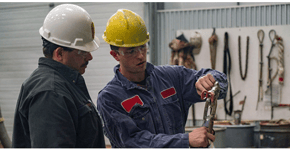Long-Term Performance of CP Systems on Bridge Structures
May 12, 2023 •Corrosion CONTROLLED, Corrosion Essentials, Coatings

 A five-year study to evaluate the long-term performance of various cathodic protection systems installed on bridge deck and substructure elements and on the underside of a roadway slab inside a tunnel was initiated in 1994. This work was a continuation of a portion of the research completed under the structures segment of the strategic highway research program. The performance of 10 of the CCP systems included in this study is discussed. These systems have been in service 5 to 15 years.
A five-year study to evaluate the long-term performance of various cathodic protection systems installed on bridge deck and substructure elements and on the underside of a roadway slab inside a tunnel was initiated in 1994. This work was a continuation of a portion of the research completed under the structures segment of the strategic highway research program. The performance of 10 of the CCP systems included in this study is discussed. These systems have been in service 5 to 15 years.
The Situation
in 1988, the strategic highway research program mandated by the US Congress, launched multiple research efforts to study all aspects of reinforced concrete deterioration three of these SHRP programs (C-102-D, C102F, and C-102G) established numerous field sites to study the effectiveness of CP, electrochemical chloride extraction (ECE), and corrosion inhibitors (CI) in mitigating corrosion of reinforced concrete bridge structures. These programs were completed in June 1993.
To obtain long-term performance data on the corrosion protection systems at the sites established or identified by the SHRP programs, the Federal Highway Administration (FHWA) initiated the subject research study in July 1994. Also included were laboratory concrete slabs that had been prepared by the SHRP efforts and then treated with ECE and CI.
The primary objective of the overall effort was to determine the effectiveness of CP, CI, and ECE through a five-year evaluation of 31 bridge structures and one tunnel; 10 of those brick bridges become became the focus of this case study. CP systems were installed on conventionally reinforced bridge decks and substructure components and inside the tunnel.
All pertinent information regarding the condition of the concrete bridge components prior to installing the CP systems, information pertaining to installation of the CP systems, structure drawings, and history of operation, where available, were obtained and reviewed in each case. The tests and survey techniques included but were not limited to:
- Electrical Continuity Testing
- Polarization/Depolarization Testing
- Embedded Instrument Evaluation
- Anode to Reinforcing Steel Alternating Current (AC) Resistance
The Resolution
The five different CP systems used during evaluations included a conductive coke asphalt system, a conductive polymer mounded anode system, a titanium mesh anode with overlay system, and a conductive coating system.
Results included:
- The three conductive coke breeze anode systems have been satisfactorily providing the required current to protect the steel, without any indication of anode degradation, for five, eight, and nine years, respectively.
- The CP system components of the mounted conductive polymer system are functioning properly. However, the effectiveness of the system in mitigating corrosion is less than desirable based on the level of polarization achieved. This may be corrected by simple adjustments of the current output from the rectifier.
- The titanium mesh anode CP systems on three bridge decks are performing satisfactorily after 6, 7, and 12 years of operation, respectively.
- The titanium mesh anode system encapsulated in a shotcrete overlay in the Brooklyn Battery Tunnel is not providing adequate protection and is considered to be ineffective.
- One conductive coating system reached the end of its service life in less than eight years. The other system continues to provide protection in the majority of areas, but it is considered to be deteriorating with time.
- Some degree of embedded instrumentation malfunctioning was found at most sites. Particularly, voltage probes and molybdenum/molybdenum-oxide reference cells have been very prone to failure. In some cases, the problem is exasperated over the life of the system. As more embedded instruments fail, fewer sites will have sufficient operational instrumentation to facilitate proper monitoring. At sites with no embedded reference cells, potential wells and external reference cells were used. (The reliability of this method is questionable.)
- The AC resistance test and limit criterion for assessing the functionality of embedded reference electrodes needs to be reevaluated considering the findings of the study. II
This study was presented at CORROSION99. It will appear in full in the book, Bridges – A Look Back: Case Studies in Cathodic Protection. For more information, go to https://store.ampp.org/.
This article by Jean Broge was originally published online for Infrastructure Insights Magazine. Republished with permission.
Check out AMPP's Highways and Bridges articles, related courses, and certifications. Keep reading to find out more.
More Industry Resources
Check Out AMPP Courses and Certifications
Explore our full list of courses, broken down by topics, and click the one that interests you the most to learn more.
Drones and the Future of Corrosion Inspections
The past five years have seen a surge in drone usage for engineering inspections. The FAA predicts over 2.5 million aerial drones will be bought this year, alongside other types like wheeled, tracked, and submersible drones. Key factors for drone usage in corrosion inspection are safety and cost. This webcast will discuss how drone inspection differs between bridges, historic buildings, powerlines, and ship ballast tanks and guide you towards implementing a contracted or in-house drone inspection program.
Available On-Demand | Duration: 49 Minutes | Earn PDHs | No-Cost
Coating NYC's Tribeca Bridge and Beyond
Anthony Maracic, Vice President of Northeast Operations at Champion Painting Specialty Services Corp. (CPSSC), explains lessons learned from his company's recent project recoating the Tribeca Bridge in New York City (as featured in this new CoatingsPro Magazine case study).
Maracic also shares highlights from his 40 years in the protective coatings industry, as well as tips and tricks for the next generation of coatings contractors. (Complete Transcript)
 A Match Made in Maintenance: Bridges and Concrete
A Match Made in Maintenance: Bridges and Concrete
The debut of AMPP’s bridge-book series, BRIDGES A Look Back, focuses in two volumes on the cathodic protection of bridges' super- and substructures worldwide. The contents use historic AMPP technical papers and journal articles covering three decades of research.
You're Invited!

We are pleased to announce that AMPP is hosting two Virtual Town Hall Meetings with our new CEO, Alan Thomas. We cordially invite our valued members and customers to join us in a unique opportunity to connect and engage with our leadership team. Make the most of this remarkable occasion to interact directly with Alan and gain insights into his forward-looking plans for AMPP.
First session: May 17, 2023, at 11:00 AM - 12:00 PM ET | Register
Second session: May 18, 2023, at 2:00 AM - 3:00 AM ET | Register
You Talk...We Listen
Tell us how we are doing and what you would like to see in future blog posts. We want to hear from you in this quick two-minute AMPP poll.
NACE and SSPC are now AMPP, The Association for Materials Protection and Performance. Now is the ideal time to become or reconsider becoming an AMPP member. There are various membership levels for you to choose the one that best fits your requirements and provides you with more access to knowledge and resources. Join AMPP Today!
Get Updates
Featured Articles
Categories
- 2024 Olympics (1)
- 2024 Water Resource Development Act (1)
- Abrasive Blasting (1)
- Advanced coating materials (9)
- advanced coatings (1)
- Advanced Corrosion Control in Oil and Gas Industry (2)
- Advocacy (3)
- AI (2)
- Aircraft (1)
- Alkanization (1)
- AMPP (4)
- AMPP Annual Conference + Expo (5)
- ampp awards (1)
- ampp certification (2)
- Ampp Chapters (1)
- AMPP conference (1)
- AMPP logo (1)
- Ampp Membership (2)
- Ampp Standards (3)
- ampp training (2)
- Amusement parks (4)
- Architectural (1)
- Architectural Coatings (2)
- argonne national laboratory (1)
- Artificial Intelligence (1)
- Asset integrity (12)
- Asset maintenance (3)
- Asset Protection (1)
- awards (3)
- B2B Marketing (1)
- Bim Software (1)
- Biodeterioration of materials (5)
- Biofouling (4)
- Blasting (1)
- Bridges (4)
- career advancement (3)
- career development (2)
- cathodic protection (2)
- Cathodic Protection-CP (16)
- Ceramic epoxies (1)
- Certification (3)
- certification study guide (1)
- Chemical Injection (1)
- CIP (1)
- Civil Engineering (1)
- clean energy (1)
- Coating inspector (2)
- coating inspector job roles (1)
- Coating inspector jobs (2)
- Coating inspector program (2)
- Coatings (18)
- Coatings Application (3)
- coatings certification (1)
- Coatings failures (2)
- Coatings Industry (2)
- coatings inspection (1)
- Coatings inspector (2)
- Coatings measurement and inspection (9)
- coatings project management (1)
- Coatings Systems (1)
- Cold stress (1)
- Concrete (13)
- Concrete corrosion (1)
- concrete cracking (1)
- Conference and Events (2)
- Corrosion (26)
- Corrosion Basics (5)
- corrosion certification (1)
- Corrosion Control (17)
- Corrosion Control and Management (23)
- Corrosion detection (1)
- corrosion engineering (1)
- Corrosion Essentials (20)
- Corrosion Inspection (1)
- Corrosion Management (1)
- Corrosion Meaning (1)
- corrosion mitigation (1)
- corrosion of steel (1)
- corrosion policy (1)
- Corrosion Prevention (13)
- corrosion resistance (1)
- corrosion resources (1)
- Corrosion Under Insulation (2)
- cost of corrosion (1)
- Crevice Corrosion (1)
- Cui (2)
- Data Monitoring (1)
- decarbonization (1)
- defense infrastructure (1)
- Department of Defense (4)
- Deposition corrosion (1)
- Dissimilar Metal Corrosion (1)
- Dissolved gases (1)
- DoD (3)
- Education (2)
- EMERG (1)
- Energy industry (9)
- entertainment industry (1)
- Epoxy (3)
- exam preparation (1)
- FBE Application (1)
- FBE Inspection (1)
- Fireproofing (1)
- Flexible coatings (2)
- Flint, Michigan (1)
- Fluoropolymer coating (3)
- Forms of Corrosion (4)
- Freshwater salinization (1)
- Fusion-bonded epoxy (1)
- Galvanic (1)
- Galvanic Corrosion (4)
- General Corrosion (4)
- General Tips (1)
- Global supply chain resilience (1)
- glossary (1)
- Hand tools (1)
- honoree night (1)
- Industrial Application (3)
- Industrial Safety (3)
- Industry Best Practices (1)
- Industry Standards (2)
- Infrared Thermography (1)
- infrastructure (4)
- Infrastructure Durability (1)
- Inspection (1)
- integrity management (1)
- Intergranular Corrosion (1)
- International Maritime Organization (IMO) (1)
- Intumescent Coatings (1)
- key note speaker (1)
- leader (1)
- Machine Learning (2)
- Maintenance (2)
- Maintenance Best Practices (1)
- Maritime Coatings (11)
- Maritime industry (12)
- Maritime infrastructure (1)
- Master Painters Institute (2)
- material protection (1)
- materials performance (1)
- materials science (1)
- Membership (2)
- Membership Benefits (2)
- Michio Kaku (1)
- Microbiological forms (1)
- Microbiologically influenced corrosion-MIC (11)
- Military (2)
- Mineral constituents (1)
- MnDOT (1)
- MPI (3)
- mpi awards (1)
- mpi champion awards (1)
- mpi training (1)
- MPI Update (1)
- MR21506-2025 (1)
- National Defense Authorization Act (1)
- national security (1)
- Naval readiness (1)
- Navy (1)
- nickel-based alloys (1)
- Non-Destructive Testing (1)
- nuclear (1)
- nuclear Materials (1)
- nuclear reactor technology (1)
- Oil and Gas (2)
- Oil Fields (1)
- Organic matter (1)
- Oxgen (1)
- Paint and Protective coatings (32)
- Paint specification (1)
- pcs certification (1)
- Personal Protective Equipment (3)
- Petrochemical Plant Fireproofing Methods (1)
- Petrochemical Plants (1)
- Pipeline (2)
- Pitting Corrosion (2)
- Pitting Detection (1)
- Polymer-Based Coatings (1)
- Power plant (1)
- Power tools (1)
- PPE (3)
- Print Advertising (1)
- Print Marketing Strategy (1)
- professional certification (2)
- professional development (1)
- Protecting oceans (1)
- Protective Coatings (7)
- protective coatings industry (1)
- protective coatings specialist (1)
- quality assurance (1)
- radiation-resistant materials (1)
- Real-Time Corrosion Monitoring in Oil Fields (1)
- Rebar Corrosion (2)
- rectifier (1)
- Reliability (1)
- Remote monitoring and drones (4)
- Repaint (1)
- Restoration (1)
- ride maintenance (1)
- Risk-Based Inspection (1)
- Road deicers (1)
- Roads and bridges (1)
- Roller coaster (1)
- Rust (1)
- sacrificial anodes (1)
- Safety (5)
- Safety Standards (3)
- Salt pollution (1)
- Sensors (1)
- service awards (2)
- Ship Coatings (9)
- Shiptanks (1)
- Solvent-free coatings (1)
- Standards (10)
- Standards Committees (2)
- Steel (8)
- Steel Reinforcement (2)
- Stress Corrosion Cracking (1)
- Structural Steel (1)
- study tips (1)
- Surface Preparation (13)
- Sustainability (2)
- Sustainability and corrosion (7)
- terminology (1)
- Tools (1)
- Turbine (1)
- Types of Corrosion (1)
- Ultrasonic Testing (1)
- Uniform Corrosion (1)
- us army core of engineers (1)
- Wastewater Systems (1)
- Water crisis (1)
- Water pipe corrosion (1)
- Water quality (1)
- Water tank coatings (5)
- Water/treatment infrastructure (20)
- Waterway salinity (1)
- What Is Corrosion (1)
- Workforce development (1)
- WRDA (1)

.png?width=722&height=120&name=CROSS%20PROMO%20BANNER%20TEMPLATE%20%20(1).png)


